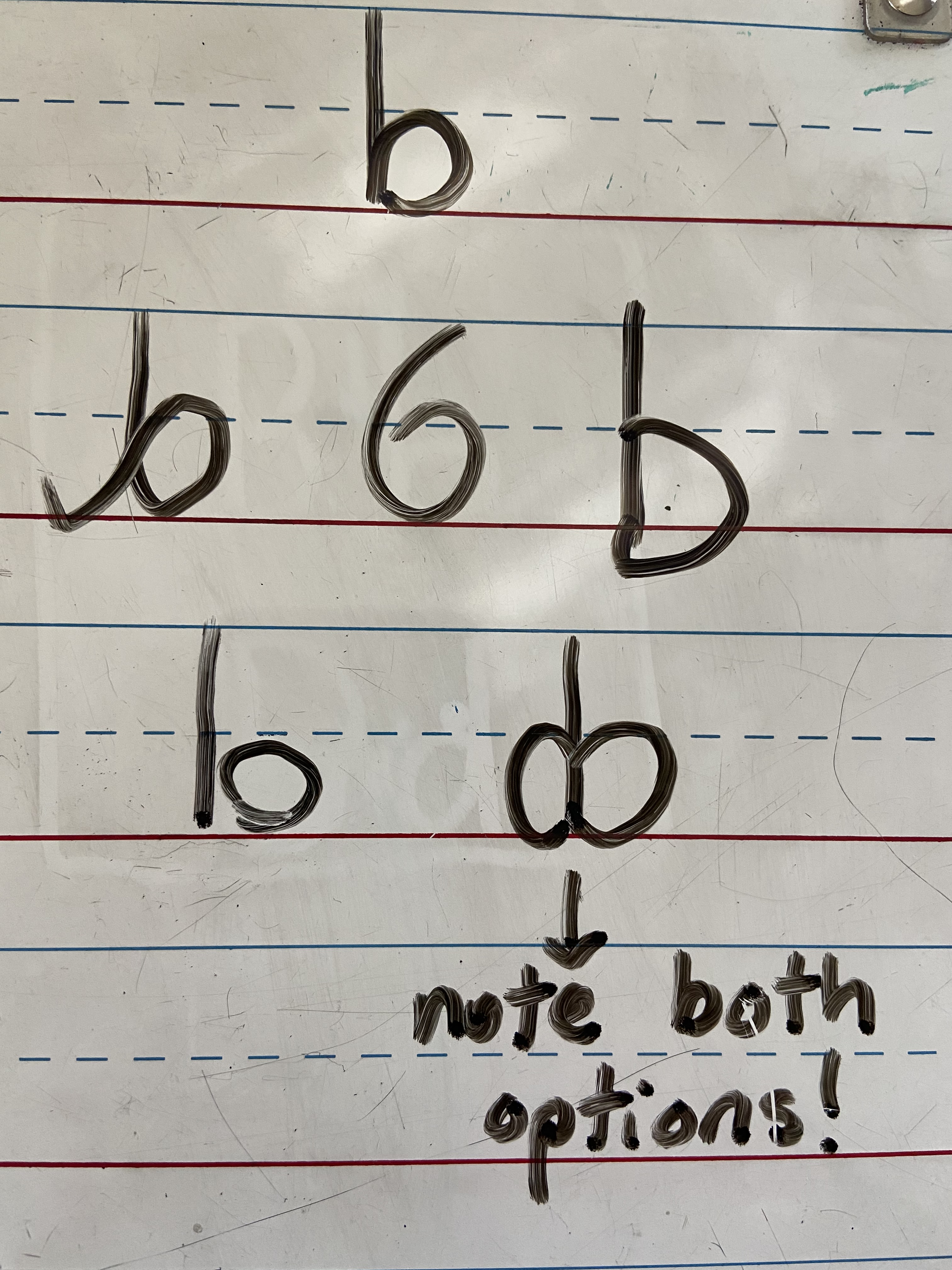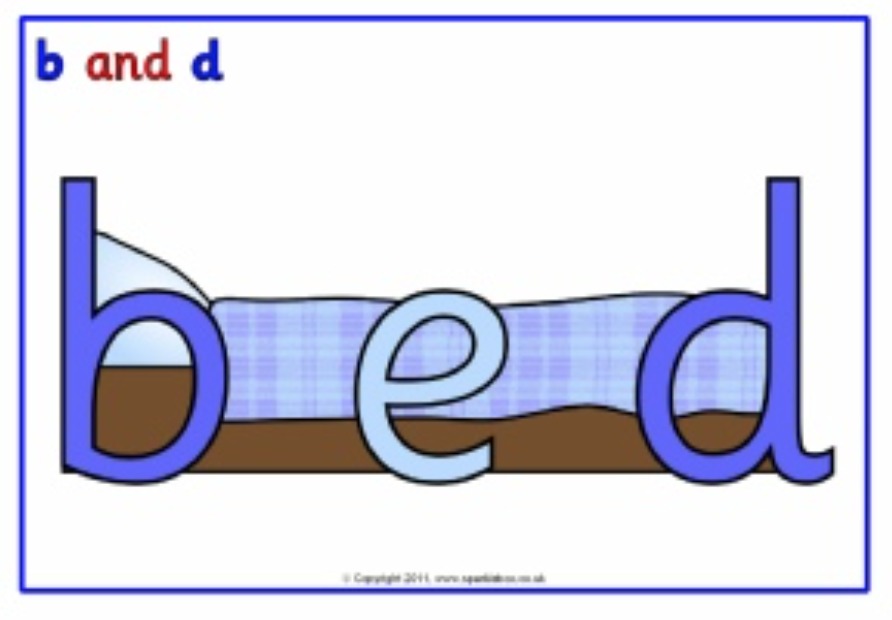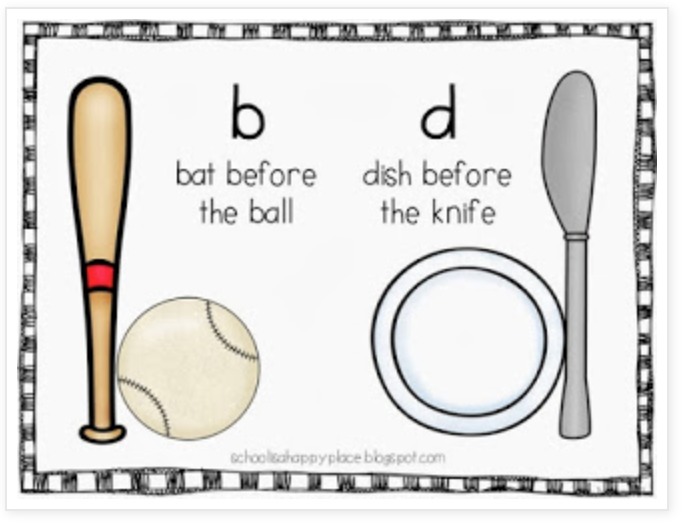Watch your ‘bs’ and ‘ds’ and “mind your ps and qs”! Notice these are plurals rather than possessives, so no apostrophes!
The necklace below symbolizes the p,q,b,d–so look closely (pqbd.org/jewelry), and was inspired by individuals with dyslexia to show support for dyslexia, start conversations, and raise funds for dyslexia organizations.
Truth #1:
Many children have difficulty distinguishing between ‘b’ and ‘d’ or ‘p’ and ‘q’–or many other letters including ‘m’ and ‘w’ (known as ‘inversions’ or vertical ‘flips’).
It is quite common for beginning readers and spellers to confuse letters, especially ‘b’, ‘d’, ‘p’ and ‘q’. Beginners also write some numbers using mirror images as well. Up until they enter school, children live in a three dimensional world in which they perceive and manipulate objects in their environments. For many, for the first time upon school entry, children are exposed to two dimensional ‘signs’ or ‘symbols’, which carry new meanings. For example, children are exposed to and must learn that ‘b’ is a symbol representing the speech sound /b/, the number ‘3’ is a symbol representing 📗📘📙 objects, and letter combinations such as Noah, Emma, William or Olivia are representations of their names.
Why is this the case?
Truth #2:
Human brains were not ‘pre-wired’ to recognize different letters portrayed as nothing but lines, curves, circles, and dots at different orientations or angles. The letters of the English alphabet are no more than different combinations of ( ), ◯, /, \, |, __, . which sometimes only differ in their orientation or directionality.

Long ago and far away, those who created different alphabets created them using these shapes because they were familiar shapes in their environments. The visual area of the human brain, located in the occipital lobe, was naturally ‘wired’ to recognize these environmental shapes, as well as human faces no matter their orientation. So…when a child sees a bird looking at it from the left, it is a bird, and when the bird turns so that the child sees it from the right, it remains a bird. If the bird is right side up or upside down, it remains a bird.
As stated, when a child begins to learn how to read and write, all of that changes…changing the orientation makes a big difference causing confusion and sometimes causing lasting consequences, not the least of which is a diminishment of self-esteem when a child is continuously frustrated and corrected when either reading, writing, or answering simple arithmetic problems. When children are taught using a code based reading/spelling program, they have a better chance of ‘unlearning’ their inborn ability to recognize objects (and therefore pay attention to directionality) than when taught using a meaning based reading/spelling program since the latter will sometimes result in children attempting to learn words as ‘wholes’ or ‘objects’.
The human brain needs to learn, of course with exposure and practice, to override its initial pre-wiring for object recognition so that the visual area is able to tell the difference between very similar looking letters, for example ‘b’ and ‘d’. The subtle differences result in visual representations of different speech sounds. Here orientation and directionality do indeed make a difference. So this new learning actually involves ‘unlearning’ prior exposure and learning. If a child confuses a ‘b’ for a ‘d’, they will end up reading a word such as ‘dad’ as ‘bab’ or ‘bad’. In turn, this impacts fluency, vocabulary, spelling,and comprehension development.

It is a simple truth that the brain requires ‘training’ at the early stages of reading to internalize and apply these minor, but important differences. When the brain internalizes these differences by creating new networks and connections, it will positively affect the child’s decoding, spelling, vocabulary, and comprehension development. This brain rewiring occurs when we learn to perceive and recognize the letters in a word in the visual cortex of the brain, understand the sounds those letters represent in the auditory cortex, and say them aloud as a spoken word in the language and motor cortices of the brain. When children learn to read, they start developing the area in our brains (the Visual Word Form Area) where the visual and auditory areas are linked, which is instrumental in allowing us to see and recognize words almost instantly. As children become more experienced and proficient readers, the VWFA more strongly activates.
Truth #3:
Letter reversals within words (or in isolation) whether reading and/or spelling are typical until children are about 7 or 8 years old (end of grade 2). Most children will ‘outgrow’ the tendency to read and/or write containing letter reversals, but that does not mean parents and teachers should ‘let it go’ until these reversals disappear naturally.
I say, “Do not wait to remediate!”
What does this look like? Be a good detective!
Watch for:
Why wait?
Repeating an error over and over again causes it to become well-established, just as habitually repeating a correct response causes it to become well established.
If you see your child continue to struggle with these types of reading and writing errors, even in kindergarten, first or second grades, I suggest you work on it in the following ways since there is no harm in helping your child to develop correct habits for reading and writing:
- Continue to read with your child, expose your child and allow your child to interact with and talk about different letter shapes. I find using posters such as the well-known ‘bed’ or ‘the bat comes before the ball/dish before the knife’, do not offer much in the way of success.
- Teach your child the correct letter formation of the ‘troublesome letters’ one at a time until near mastery is achieved. The best ways I have found to help include showing the mouth formations of the sound you are focusing upon using a mirror so children can both watch the adult forming the letter and can also see their own mouth gestures. For example, when you say the sound the letter b represents (/b/) your lips are together and emit a puff of air. When you say the sound of letter d (/d/) your lips are open and your tongue is on the roof of your mouth. It is important to link the sound, the letter name, and its formation with specific oral directions (I recommend either Learning Without Tears or Fundations) about where to start each letter and how to proceed to ensure correct formation. I also suggest teaching commonly confused letters in different groupings. For example, teach ‘b’ with this group: l, h, b, t, f, k and ‘d’ with this group: c, a, d, g, q.
- Trace, copy, write from memory, proofread in text.
- Have your child look at the text rather than at you or up in the air when reading and also after spelling to proofread.
- Keep a visual of upper and lower case letters handy for reference…this is different from bed trick, bat and ball visual, etc.
- In fact, teach correct letter formations of all the letters while you are working on this with your child. According to Learning Without Tears Consultant Megan Parker, between 10-30% of all children have handwriting difficulties.
Truth #4:
Not all children with dyslexia reverse letters when reading and/or writing. What is true is this: many individuals with dyslexia take far longer to remediate their difficulties in terms of distinguishing letters such as ‘b’ and ‘d’. This is due to the delay in or the elongated time (more practice required for those with dyslexia) these children spend developing the links between the visual-auditory-language-motor cortices of their brains.
Will these children struggle for the rest of their lives? The simple truth is likely not; if a child with dyslexia obtains remediation using a Structured Literacy approach based upon the Science of Reading, it is highly likely that the VFWA will be activated such that these reversals will be minimized and not interfere much with reading or writing. According to Dr. Sally Shaywitz of the Yale Center for Dyslexia and Creativity, “one of the most enduring misconceptions is that dyslexic children see letters and words backwards and that reversals (writing letters and words backwards) are an invariable sign.” Dr. Shaywitz posits that many children who do not experience reversals, yet have dyslexia, are often undiagnosed simply because of the common correlation between reversals and dyslexia.
Truth #5:
Many parents are concerned when their children’s writing is filled with ‘floating ps and qs (and gs)’, as well as b/d and other letter reversals. What does this mean? In my experience, many of these children have simply developed some bad habits which were never addressed.
These children may not have had explicit instruction in letter start (at the mid-line) and/or placement that extend below the baseline (bottom line) in writing. Although many students with a diagnosis of dyslexia write using misplaced lower case ps, qs, and gs, it is again something parents and teachers can work to remediate using the same techniques described in Truth #3.
Add-on Truth:
We wrote the ABCs,
and minded our
Ps and Qs.”
It’s fun for children to learn about idioms, so where/when did the idiom “mind your Ps and Qs” originate and what does it mean?
Well, first to the meaning(s)–turns out this idiom has several meanings and origins dating back to the 18th century:
1-’mind your manners’–behave in a mannerly and appropriate fashion, on your best behavior
2-‘mind your language’–speak in an appropriate fashion
3-a shorthand for saying ‘please’ (the ‘ps’) and ‘thank you’ (the ‘qs’ since the end of the word ‘thank’ combined with the word ‘you’ sounds like the name of the letter ‘q’)–that seems a bit of a stretch to me!
4-printers used this phrase since typesetters often confused ‘ps’ and ‘qs’ since they were located side by side
5-learning the alphabet! Here is a poem dating back to 1763 by Charles Churchill:
On all occasions next the chair
He stands for service of the Mayor,
And to instruct him how to use
His As and Bs, and Ps and Qs.
6-the idea of a bartender keeping tabs on how many “pints and quarts” [of ale] each of the patrons consumed to avoid unhappy circumstances of overdrinking!





So informative as usual Lori! Thank you. I have enjoyed reading your blogs. D. Eshler